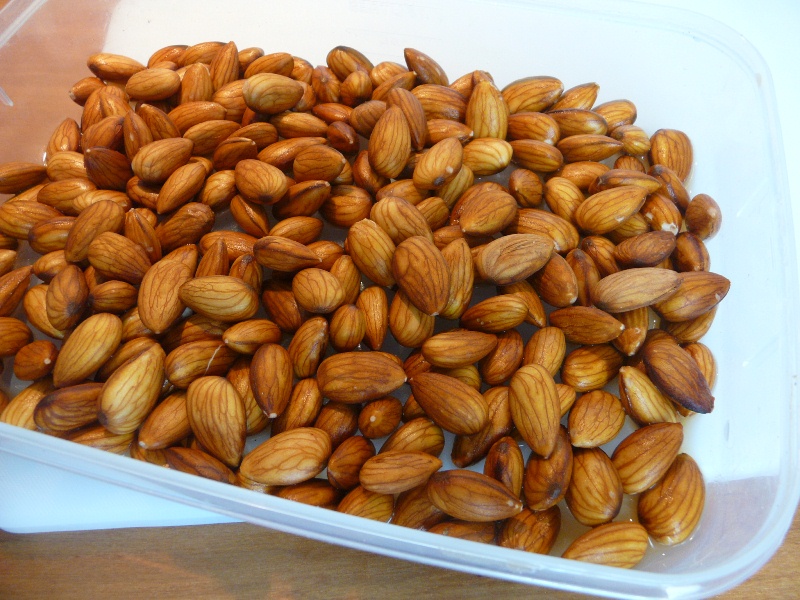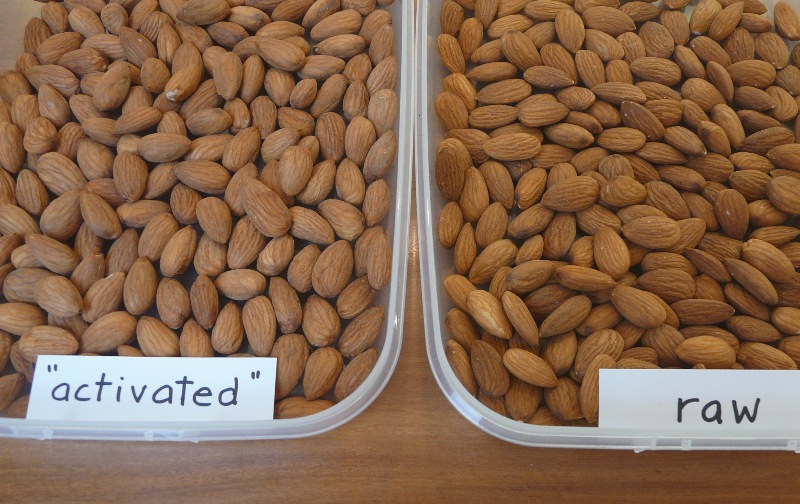Product review: activated almonds
Written by Catherine Saxelby
on Monday, 26 November 2012.
Tagged: #activatedalmonds, fads, healthy snacks, nuts, snacks

Almonds have been heavily featured in food and nutrition blogs during 2012 following the revelation of chef Pete Evans' health food diet which consisted of things like emu meatballs, cultured vegetables, apple cider vinegar, maca, spirulina, cocoa nibs, stevia, coconut chips, sprouted millet bread, and coconut kefir. And, what caught the Twitter trendline, lots of activated almonds!
I puzzled over exactly how almonds were transformed from common almonds to the rarefied status of activated almonds. Having never carried out the activation process myself, I followed the steps outlined very elegantly by Easy Peasy Organics in her blog then I gave them the Foodwatch Product Review once over.
How to activate almonds
I started with a 500 g pack of raw almonds. These are the almonds I usually eat straight from the pack or mixed with some dried cranberries or raisins for a quick afternoon snack.

After soaking, the nuts looked golden and puffed-up with their tiny 'veins' prominent. A couple had split in half and a few showed a little bump at one end where the new shoot was starting to sprout i.e. germination. Otherwise there was nothing vastly different to notice. I didn't see any green shoots popping up but maybe the soak wasn't long enough. I don't know.

They spent 24 hours (yes!) in my slow oven at the lowest temperature setting of 50 degrees C (120 degrees F) drying out and losing that absorbed moisture. I taste-tested them after 8 hours, then after 12 hours then let them sit all night in the oven at that low temperature – think of the cost of running your oven for 24 hours straight. No wonder they're so expensive.
Nutrition 9/10 - the same as for raw almonds
There are three main claims made about 'activated' almonds. Health websites say the soaking and heating (partial-germination) is supposed to:
1. make the nuts 'more digestible' than natural or roasted almonds.
2. encourage the production of beneficial enzymes, whatever they are.
3. destroy or neutralise 'enzyme inhibitors' that 'strain your digestive system'.
Read more from my post on the topic here.
My response to these three claims
1. Firstly the germination process converts some (not all) of the complex starch into simpler sugars and converts some (not all) of the protein to smaller sub-units of amino acids called peptides.
After all, almonds botanically are the seed of a new plant which will start growing once it receives enough moisture and warmth. The endosperm carries starch and protein which is fuel to keep the new germ going until the emerging plant shoot can start its own photosynthesis to generate energy.
So, yes, there's less starch and protein and more sugars and small peptides in germinated nuts. Does this make them more 'digestible'? I don't think so. Our bodies are capable of breaking down starch and protein.
2. Germination DOES harness enzymes in the almond into production so the new seed can grow but whether these are the same enzymes we need to digest our food no-one knows.
3. There's precious little research into nuts but I did find a lot from studies on grains and legumes. I'm assuming things are similar.
Grains, legumes, nuts and seeds contain protease inhibitors (also called trypsin inhibitors – trypsin is an enzyme that breaks down protein in our stomachs) that stop our digestive enzymes from breaking down proteins. Seeds have them so that in the event they're swallowed, they will escape digestion and will be eliminated in the faeces while still viable. Clever!
Protease inhibitors are reduced by the heat of cooking as well as by soaking. That's why the pre-soaking of chick peas or soy beans or soaking and cooking barley or rice is so important.
In addition, all of these contain phytic acid or phytate, a natural compound that is the storage form of phosphorus. It's high in brans and whole grains, less of a problem in nuts. Yeast fermentation during breadmaking reduces phytate levels.
In diets where 70 per cent of the food comes from unleavened flatbreads, phytate is an issue as it can block absorption of zinc, iron and other minerals into the body. I recall studies of teen boys in the Middle East who failed to grow and mature due to lack of zinc from all the flatbread in their diet (note their diet was marginal in other respects with very little meat, fish or eggs and other key foods).
Tannins or polyphenol compounds are also present and like phytate can bind to calcium and iron and block absorption. Hence these two are often called anti-nutrients.
Other things to ponder
- No-one knows how long you need to soak and heat the almonds to start the germination and then stop it.
- Some sites claim that soaking makes the B vitamins increase. This may be true but then the 24 hours heating would surely knock these B vitamins on the head.
- Yes, almonds are high in calcium but nowhere in the range of milk, yoghurt or cheese. Their calcium is simply not absorbed as well.
- I don't see how anyone can call activated almonds "raw food" after they've gone through a long heating and drying process.
- Chewing or grinding any nut releases more fat and more minerals and vitamins. If you want the most nutrients, chew them really well or grind them up and sprinkle over muesli etc. That's important advice if you eat raw flax seeds and raw nuts regularly for their nutrients.
Taste 9/10
The activated almonds taste – wait for it – just like regular almonds that have been roasted in an oven for 30 minutes to crisp them up. They had a smooth uniform appearance but an attractive crunch. Close up I noticed that some of their skins were starting to flake off due to the soaking. See the side by side comparison shot.
I started tasting them after 8 hours – at first they were soft inside from the water but after 12 hours they got crisper and finally really nice and crunchy after the full 24 hours.
Disappointingly, a week later, they tasted dull and little "old" and stale and were not so attractive to eat despite being stored in an airtight container. So the oven heating is the way to go if you like crisp crunchy almonds.
Convenience 2/10
There's nothing convenient about the time it takes to produce activated almonds. No wonder they cost so much at health food outlets.
The bottom line
Activated or not, almonds are extremely nutritious and a worthy inclusion in anyone's diet. If your diet is composed of 70 per cent or more almonds (and whose is?), then having all their nutrition fully available is important so the soaking and drying makes sense. However, if you eat a mixed diet, with the odd handful or two of almonds a day added to vegetables, whole grains, avocado, seeds and fish, then the level of vitamins, minerals and protein from the nuts probably isn't critical.
Foodwatch
The Good Stuff
The Boring Stuff
© 2025 Foodwatch Australia. All rights reserved
Website by Joomstore eCommerce






